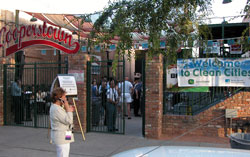 Senator John McCain, future presidential candidate, delivered a wonderful speech on the future of alternative fuels. The United States is deeply dependent on foriegn oil. The U.S alone uses about 7.6 billion barrels of oil a year. By using alternative fuels, you reduce the greenhouse emissions. An option proposed to help our environment and economy is to raise Corporate America Fuel Efficiency standards. There are currently 5 million flex fuel vehicles on the road but more are on the way. James D. Boyd talked about domestic fuels and its problems. California is the 5th largest economy and consumer of energy in the world. California is the second largest consumer of gas and diesel, the largest consumer is the United States. Many alternative fuel vehicles will be taking up the roads in California within the next year.
Senator John McCain, future presidential candidate, delivered a wonderful speech on the future of alternative fuels. The United States is deeply dependent on foriegn oil. The U.S alone uses about 7.6 billion barrels of oil a year. By using alternative fuels, you reduce the greenhouse emissions. An option proposed to help our environment and economy is to raise Corporate America Fuel Efficiency standards. There are currently 5 million flex fuel vehicles on the road but more are on the way. James D. Boyd talked about domestic fuels and its problems. California is the 5th largest economy and consumer of energy in the world. California is the second largest consumer of gas and diesel, the largest consumer is the United States. Many alternative fuel vehicles will be taking up the roads in California within the next year.
Domestic Fuel coverage of the Clean Cities Congress is made possible by the following sponsors:




 Our energy roundtable moderator this morning was Andrew Littlefair, CEO of
Our energy roundtable moderator this morning was Andrew Littlefair, CEO of 
 The Executive Director of the
The Executive Director of the  Our final day general session is going on right now.
Our final day general session is going on right now.
 The Clean Cities Congress crowd kind of changed the slogan for Alice Cooper’s Town a little last night to “Where Rock and Alternative Fuels Meet.”
The Clean Cities Congress crowd kind of changed the slogan for Alice Cooper’s Town a little last night to “Where Rock and Alternative Fuels Meet.”
 The band at our closing reception was Still Cruisin led by founder and drummer Bill Ball.
The band at our closing reception was Still Cruisin led by founder and drummer Bill Ball. The closing reception was held last night at
The closing reception was held last night at  On my way out of the convention center yesterday I stopped by the Ride & Drive and found myself in a
On my way out of the convention center yesterday I stopped by the Ride & Drive and found myself in a  At the end of the day today participants here at the Clean Cities Congress could ride and drive a variety of alt fuel vehicles.
At the end of the day today participants here at the Clean Cities Congress could ride and drive a variety of alt fuel vehicles.